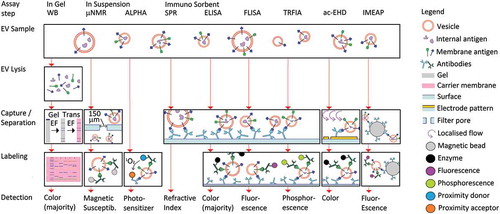Figures & data
Figure 1. Schematic overview of bulk immunoassays for EV characterization. Western Blot (WB) performs EV lysis, gel electrophoresis (EF) of all protein content, and transfer EF to a membrane for subsequent immuno-labeling. Micro-Nuclear Magnetic Resonance (µNMR) selects EV sizes by filtration, and labels EV with immunomagnetic particles for subsequent detection of the magnetic susceptibility of the sample. Amplified Luminescent Proximity Homogeneous Assay (ALPHA) detects transfer of singlet oxygen from the donor to the acceptor if they are in close proximity, i.e. bound to an EV. Surface Plasmon Resonance (SPR) captures EV on an immuno-functionalized surface, and detects the resulting change in refractive index. The other immunosorbent assays are all variations of the sandwich Enzyme Linked Immuno Sorbent Assay (ELISA), where capture of EV on a functionalized surface is complemented by detection of a different antigen, or epitope. The reporter molecules can be enzymes (ELISA), fluorescent molecules (FLISA, Fluorescent Immuno Sorbent Assay), or phosphorescent molecules (TRFIA, Time-Resolved Fluorescent ImmunoAssay). To overcome the mass transport limitations near a surface, electrohydrodynamic-induced nanoshearing (ac-EHD) generates additional flow near the surface, while the Integrated Microfluidic Exosome Analysis Platform (IMEAP) mobilizes the surface itself by means of immunomagnetic beads.

Table 1. Comparison of bulk immunoassays for extracellular vesicles (EV).
